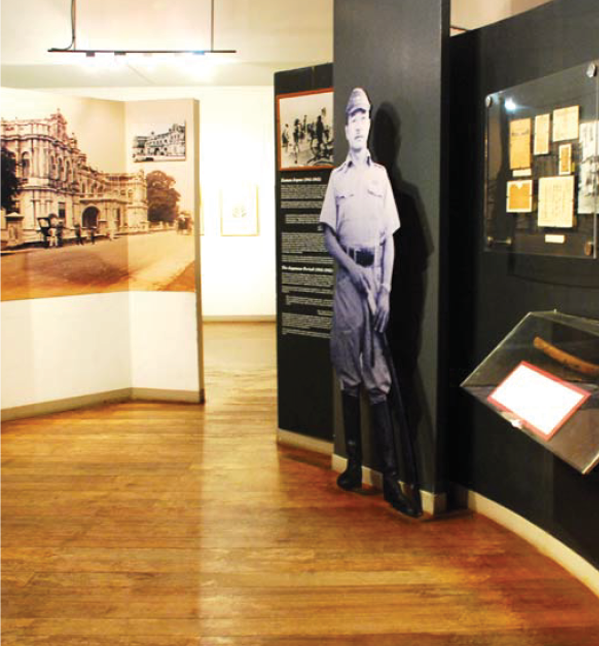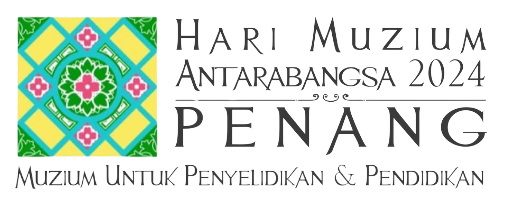
The building was occupied by the Penang State Museum about three years ago. This historical building was declared as a heritage building category II. Built in 1912, this more than a century old building is still standing as majestically as ever.
ABOUT US
About Museum (No. 57 Macalister)

Museum Building
At No.57 Macalister Road
Its history began when the land on which the building stands was transferred to William Evans (Resident Councillor) and William Peel (President, Municipal Commissioners in Penang) as Trustees in a written agreement on 05th February 1912. The transfer fee was paid from the King Edward Memorial Fund. This fund is derived from fees and donation from Penang people as a private enterprise.
This fund was made possible through donations from members of the Penang business circles. A plaque at the building shows the donors’ names and the amount that was collected being $65,435.
The aim was to build a maternity hospital on the land. In 1915 by order of the Supreme Court, this land was vested to the George Town Municipal Commissioners as the trustee of the King Edward Memorial Fund. The court order called for the original building to be used for charitable purposes. Now, the George Town Municipal Commissioners are known as Members of the Penang Municipal Council (MPPP).


Maternity Hospital
Of King Edward
VII Memorial
On 12 November 1908, “Pro Bono Publico” announced in the Straits Echo newspaper that a Penang Maternity Hospital will be built; similar to the one in Singapore. The Maternity and Children’s Hospital in Macalister Road was expected to be completed and used at the end of June 1915. The building would be operated by the Penang Municipal Council.
The first obstetrician who worked as a medical officer in the first Maternity Unit in Penang was Dr. George W. Park. Ms Macdonald who was appointed as the Head Nurse was well known in Penang as an efficient and competent nurse. She was assisted by two nurses and two midwives.
At that time, two employees worked full time while eight part-time. The hospital provided 50 beds under all classes. Surgical cases continued to be sent to the General Hospital, Penang.


On 13th September 1915, Alferd Thomas Bryant, Resident Councillor of Penang (1914–1917) inaugurated the Maternity Hospital and a celebration was held for the occasion for the community. He read a telegram from the Governor, Sir A. H. Young, K.C.M.G.: “I regret that it is not possible for me to be present today at the opening of the Maternity Hospital. I send you my best wishes for the success of Penang’s memorial to the late King Edward VII, whose constant care was for welfare in this area”.
A. T. Bryant acknowledged that Mr. Stark and McNeil, the architects and Mr. Robert Young, the contractor be given due recognition for the building of the hospital. He expected this initiative to succeed and help reduce the infant mortality rate. Mr. Stark and McNeil started a partnership in the firm, Stark & McNeill in 1912 with offices in Penang, Ipoh and later in Johor.
A. T. Bryant acknowledged that Mr. Stark and McNeil, the architects and Mr. Robert Young, the contractor be given due recognition for the building of the hospital. He expected this initiative to succeed and help reduce the infant mortality rate. Mr. Stark and McNeil started a partnership in the firm, Stark & McNeill in 1912 with offices in Penang, Ipoh and later in Johor.
In October 1916 through the generosity of Mr. Lim Cheng Law, the Maternity Hospital in Penang was supplied with two up-to-date electric sterilisers at a cost of about $ 1,000. These sterilisers were a great acquisition and were considered sophisticated in this country at that time.
Dr. George W. Park retired in 1917. He was succeeded by a specialist, Dr. J. S. Rose who served until 1927. Based on the book “Penang: Past and Present 1786-1963”, Dr. Rose began services dealing with epidemics of diseases like influenza, plague, and smallpox prevalent in 1918 to 1919. The first case of influenza was reported in July 1918 and there was a fresh outbreak in October.

Infant mortality dropped from 367 in 1904 to 155 in 1923 among an increased population. In 1961, with a population of 234, 903 infant mortality rates stood at 307. The infant mortality rate decreased further to 36 in 1961.
In 1935, C1 and C2 wards at the ground floor of Block C became the maternity ward. Due to the expansion of the building, the construction of a new maternity hospital began in 1939 on Residency Road. When the existing hospital was demolished, the Commissioner converted it to a public or recreation park in memory of King Edward VII. It was completed in 1941 at a cost of $550,000. This Maternity Hospital replaced the existing maternity hospital in Macalister Road.
In 1940-1941, during the Japanese occupation it was used as a Naval Hospital until the Japanese surrendered in September 1945, and the British used it as their barracks. The building was later used as the Health Office and the Registry Office. In 1947, the hospital was reserved for maternity cases only. The hospital has first, second and third class wards with a total of 120 hospital beds in all classes. Emergency cases were still sent to General Hopital until the mid-1950s.

Dr. Lee Keng Soon served as a medical officer of the hospital which began services in September 1950. He was from the O & G Specialist Hospital. After his retirement, Dr. Seevanathnam succeeded him at the beginning of January 1951. Dr. Sivanathan was assisted by one or two medical officers. Matron Counsel and Sister Quiein treated the cases, assisted by 16 to 18 midwives.
According to birth statistics in August 1950, the King Edward VII Memorial Maternity Hospital had welcomed 60,000 births after 29 years of operation. An estimation of more than 4,000 deliveries were recorded every year. The workload increased with the increase of childbirths.
The complex was used as the Maternity Hospital until 1955 when it moved to its current site at Residency Road near the Penang General Hospital. From 1950-1980, this building was used as the headquarters of the St. John’s Ambulance and the Red Crescent Society, and a training centre for adult education. It was also a centre for many non-profit and private organisations.











